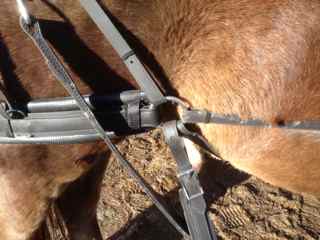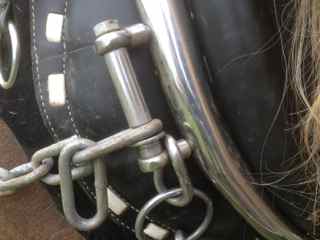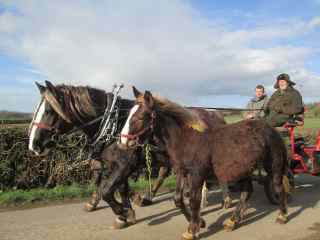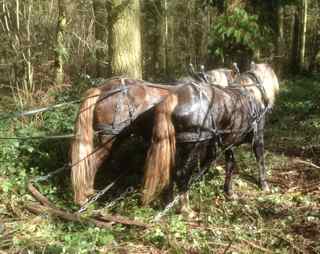Childer Wood Heavy Horses
| Homepage |
Horse
Logging |
Training Courses |
Horse Logging Equipment | Woodland Products | Working
Horse Shows |
Working
Horse - Links |
British Horse Loggers |
NEW HARNESS SET UP
Ideas about how to set up, amend and adjust harness keep going round and round. Here is my latest offering on the subject. This harness works superbly and I am delighted that it has all come together. Doubtless there will be some other small change that will just make the difference....
I have been using Canadian harness from Aaron Martin (www.aaronmartin.com) for some years having always used their collars coupled with a Tarnsjo harness to take Scandinavian shafts previously. I moved to a full set of their harness to work my horses as pairs with traces and a double tree or a vehicle with a pole rather than double shafts. Complications arose with the need to work a horse in shafts as well as traces and I ended up with two sets of harness for the cobs. This was then further compounded by building the big forwarder which worked with double shafts so needed Scandinavian style harness attachments.
I could attach traces to the Scandinavian harness. I had been doing so for years using chain traces with draught springs but, having read Paul Schmidt's excellent research on the matter, I wished to use webbing traces. I did attach an adapter kit to the Aaron Martin harness but using the traces as well proved problematic; if both were in the tug hooks at the same time they could become jammed and the solution was to move them so that whichever system was being used was in the bottom of the tug hook so it could work without jamming. Clunky.
So, with new horses arriving and harness shopping beckoning (I do love it when those big boxes arrive from Canada!) I dreamt up some key changes.
Following on from my previous offerings on harness there are several key points that must be got right and others that are very desirable, increasing efficiency and welfare.
Firstly, the collar and sweat pad must fit properly. Secondly, the tugs must be adjustable to ensure the pulling ring is correctly positioned when under traction. Thirdly, the horse needs a good angle of draught from the collar to the load and effective britching to be able to use its force to the maximum effect with the greatest comfort. Fourthly, it is ideal if the traces are attached to the pulling ring rather than direct to the collar to avoid jamming the tug hook and to allow the belly band rather than the horse's windpipe to take any upward force on extreme slopes. Finally, it is really useful to be able to switch from singles to pairs and from shafts to traces without changing any of the harness (except from the reins, of course).
I ordered my new harness, a rather stylish 'granite' pairs harness with Coblenz collars. Granite is leather-look biothane wrapping strong webbing. Coblenz collars are renowned for their efficiency and build. All of this is refreshingly affordable compared to Scandinavian and leather harness. I ordered two extra 'hold backs', what we call britching, for each horse. I cut and shortened the traces and re-attached them directly to the pulling ring. As I intended to keep the harness intact I dispensed with my usual tug hooks and attached my adjustable tugs to the posts on the hames.
We have now thoroughly tested the harness and it works like a dream. I follow with some photographs to illustrate the text

The harness on Salva. The tugs are chain and, therefore, adjustable. Note that a link has been dropped to allow adjustment. Spare links will be cut off once I am happy with the adjustment. This adjustment can change over time as the collar 'beds in'. One pair of the holdbacks or britching attaches to the pulling ring and the second pair of hold backs go under the belly to the D ring on the martingale for working as a pair with a pole. The traces are permanently attached and, as they are webbing, they are light and do not 'clash' with the shafts.
The harness is always ready for work whether with a single, a pair, in a pole for pairs work and in shafts, either single or double, without any changes or alterations.

A detail of how the two hold backs are attached to the britching. The upper goes to the pulling ring and the lower under the belly to the martingale. Note the extra padding with a britching pad and the trace carrier. The traces clip up to a hook on the harness and are out of the way.

A detail of the pulling ring. Tug, back band, belly band and britching attached as usual. Traces fixed above pulling bar and chain tugs going forward to the collar. The traces are above the pulling bar so that when in use the pulling bar can hang freely. When the shafts are used the pulling bar sits where the traces are now, fitting comfortably with the traces. The line of the back band and belly band, when at rest as in this photo, is pulled slightly forwards so that when the horse comes into traction the pulling bar sits in the hollow behind the front leg and away from the body. Sitting further back could result in it hitting the ribs, 'kicking' the horse on and causing discomfort. If your horse works faster than you would like when in shafts, check this adjustment.

Detail of attaching to pillars on hames without the need for a tug hook. The chains hook onto any tug hook easily. Note the height adjustment for a good angle of draught, yours may need to be different.

The harness as a pairs harness with a pole on the Hillams; Glyndwr tied alongside Agua and Salva.

Agua and Salva with the double tree.

Tushing soft wood saw logs with the double tree.
to contact Doug Joiner:
by phone or fax: (+44) 01531 640 236 or on his mobile: (+44) 07773 900 751
or by post: Heavy Horses, Hill Farm, Stanley Hill, Bosbury, LEDBURY, HR8 1HE
Herefordshire